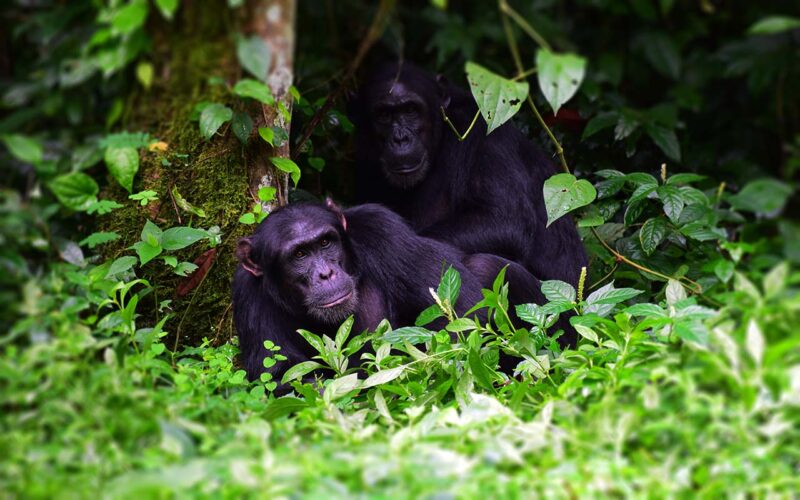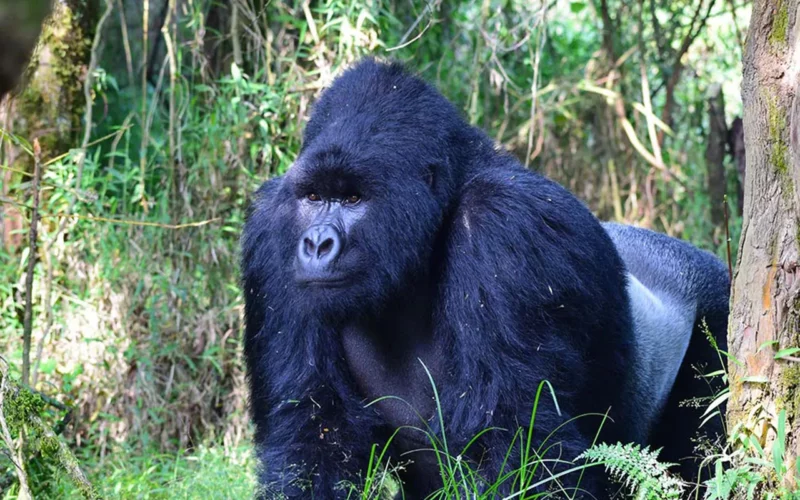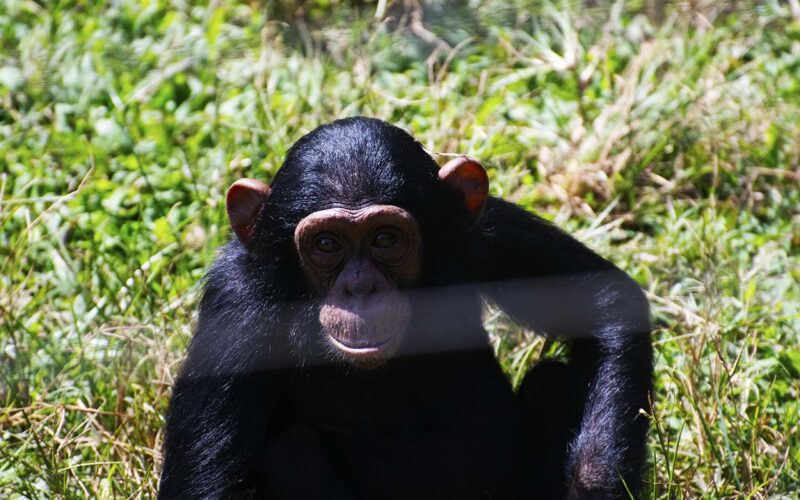Frequently Asked Questions (FAQ) about Mountain Gorilla and Chimpanzee Trekking in Uganda
In these Frequently Asked Questions about Mountain Gorillas and Chimpanzee Trekking in Uganda we bring you tips, firsthand information, personal experiences and inspiration to help you as you plan that lifetime trek personal encounter with man’s closest ape relatives in their Uganda’s pristine rainforest habitats.
A trek along mountain gorillas and chimpanzee is often dubbed a “once-in-a-lifetime experience” and a privilege, where you trek to a face-to-face encounter with these two of the biggest apes. It’s a thrill and personal experience hard to express in words, as you observe and watch human-like gestures, expressions and interactions of these apes within their natural habitats. That feeling of recognition or rather acceptance felt when you come into on a face-to-face encounter with gorillas or chimpanzee is personal and leaves lifetime memories.
Where to track Mountain Gorillas in Uganda
Mountain gorilla trekking expereince is offered in Uganda’s UNESCO heritage site of Bwindi Impenetrable Forest NP and Mgahinga Gorilla NP that collectively protect up to 54% of the global population of the endangered mountain gorilla. In these pristine rainforests, visitors can only trek up to 20 gorilla families, habituated and available for daily trekking experience.
Where to track Chimpanzee in Uganda
Uganda offers a rewarding trek expereince to encounter the chimpanzee across various tropical forests. Chimpanzee is the closest man’s relative ape sharing similar social traits and demonstrating a high level of intelligence including manipulation of tools. They have a smaller build than mountain gorillas, more mobile occurring in large multi-male dominated communities averaging over 120 individuals and controlling large territories.
In Uganda, chimpanzee occupy a wide range of forest types from montane rainforests to lowlands and riverine extending even onto savanna woodlands. Chimpanzee trekking experiences is offered in the following selected sites named according to the quality of sightings and chances on the experiences.
- Kibale National Park is the primate’s capital with 13-species of primates
- Kaniyo Pabidi section of Budongo Forest in Murchison Falls NP
- Kyambura Gorge in Queen Elizabeth NP
- Kalinzu Forest close to Queen Elizabeth NP
- Ngamba Islands in Lake Victoria

What is the best time to Track Gorilla and Chimpanzee in Uganda
Mountain gorillas and chimpanzee trekking experience in Uganda is an all-year-round activity however local weather and climate patterns influence the expereince greatly. Mountain gorilla trekking expereince is best achieved during the the dry months between June to September and December to February. The wet season starting from late March to early May, and late September to November brings in more rains, making forest trails slippery and therefore gorilla tracking experience a tough adventure! But for those seeking a rewarding and a more personal adventure, these wet months offer just that – due to the low traffic of travelers. More so, during the wet season, the rainforests have abundant food making the terrestrial feeding mountain gorillas more predictable as they don’t need to move a lot and far for food.
With that in mind, it is important to note that these are rainforests and it can rain anytime of the day! As a guideline however, local average temperature is tempered by high altitude with daily maximums of 19-27 C with minimums of 12-18 C.
Chimpanzee trekking expereince is conducted across various Uganda’s mid-altitude forests that receive less rains compared to the montane regions making the trek expereince an all-year-round adventure regardless of season.
How to obtain a Gorilla and Chimpanzee tracking permit in Uganda
Gorillas and Chimpanzee trekking permits are high demand and ought to be booked and paid in full in advance way before the trekking date. These permits can be booked and paid through a registered local tour operator or directly from the Uganda Wildlife Authority. Permits come into two distinct trek expereince categories and price tags where an ordinary gorilla trekking expereince permit cost 800 USD and habituation trekking experience costs 1500 USD.
Chimpanzee trekking expereince permits also require booking in advance especially when tracking in the primates capital of Kibale National Park, Africa’s prime Chimpanzee tracking location. just like mountain gorillas, trek permits come into two categories namely ordinary trekking costing 250 USD and habituation trekking experience costing 300 USD.
Chimpanzee tracking in the Kyambura Gorge of Queen Elizabeth National Park, a unique ecosystem of underground tropical forest in the middle of the golden savanna, permit cost is 100USD park entrance excluded. Other tracking location sites in Uganda requires no prior booking and attract lower cost.

What is the difference between Gorilla Habituation vs Ordinary Trekking Experience?
Uganda offers two trekking options to the endangered gorilla and chimpanzee that differs in experience and of course price. On habituation experience, only a small group of tourists (4 maximum) are allowed to trek with researchers along a gorilla families undergoing a habituation process. The tougher habituation experience involves a long trek deep in the forests usually very early in the mornings and takes longer than Ordinary Tracking. It’s important to note that such gorilla families, tend to be mobile making trekking longer and harder (depends on the range and territory) are not yet used to human presence and are very shy and protective, making them less predictable than the fully habituated families.
Ordinary Gorilla tracking involves visitors to gorilla groups that are fully habituated (used to human presence) whose territories are well known and offers great viewing experience. Usually, visitors get to spend strictly one–hour with gorillas and chimpanzee.
NOTE: The same options are offered on chimpanzee tracking experience.
How fit should one be to trek mountain Gorillas and Chimpanzee in Uganda?
Mountain gorillas range over higher altitude range from 1060m all the way to above 4000m where the terrain is diverse, from sharp ridges and moist valleys therefore requiring average fitness. Given the altitude where mountain gorillas ranges, one is required to seek advice from their private health doctors before the trip. The experience largely varies to what season one chooses to trek in – the rain season is challenging with wet and slippery trails, with drizzling at night and late afternoons.
Chimpanzee trekking expereince happens in several mid to low-altitudes forests lying on gentle forested hillsides but still average fitness is required.
How big are Gorilla and Chimpanzee trekking groups?
Although mountain gorilla and chimpanzee trekking experience are Uganda’s premier attractions and popular adventure, the country practices a strict conservation approach of these endangered primates and their shrinking rainforest habitats. In ensuring conservation to both these iconic primates and their shrinking habitats, only a small fraction of both populations of mountain gorillas is habituated for tourism and research purposes.
Thus said, the number of dairy trekking visitors on an ordinary mountain gorilla trek expereince is strictly limited to a maximum of 8 persons assigned to trek up to one-gorilla family. And once located, visitors are allocated only 1-hour to interact and observe the gorilla family. The number of visitors on habituation program is even smaller and limited to 4 individuals where they join a research team of rangers to trek to a semi-habituated chimp/gorilla group for a duration of about 4 hours with mountain gorillas.
How long is the Gorilla/Chimpanzee trekking duration Experience?
A gorilla and chimpanzee trekking expereince duration varies daily and depends on the location of the gorilla/chimp family home range/territory from the tracking point. However, the duration ranges from as short as 2/3 hours for the chimpanzee and 5 – 7 hours for mountain gorillas.

What is the age limit for Gorilla and Chimp tracking in Uganda
Currently the age limit for gorilla tracking in Uganda is 15 years old. Age limit for the chimpanzee tracking is 12 years.
Do I need a Helper/Porter during a Gorilla tracking experience
Hiring a porter for the gorilla trek is highly recommended. The porter will help carry that heavy backpack and even support you across and along difficult terrain in these rainforests. Porters are available at all trailheads and always the ranger guides will ask if you need one. Remember they come from the communities surrounding these fragile ecosystems, and this another way to directly support these communities. They come at a minimum fee of 15USD.
Tipping on a Gorilla or Chimp trekking expereince in Uganda
Although tipping is NOT mandatory, visitors to Gorilla and Chimpanzee tracking are encouraged to give an appreciation to the staff involved in these activities given that most of them come from the surrounding communities around these protected ecosystems. How much you tip…..is a heart-issue; but what a difference it makes!!
What to pack for Gorilla and Chimpanzee tracking in Uganda
When preparing for a mountain gorilla and chimpanzee trekking expereince it is important to note that these endangered primates dwell in typical rain forests and across high altitude ranges ranging from 1650m to over 3000m. If you come from low-altitude countries, make sure to consult your general practitioner (GP) for advice on altitude related challenges. On clothing, nature blending colors are advisable except military camouflages.
The packing list therefore includes;
- Raincoat or poncho is essential for you and your cameras regardless of the season
- Gardening gloves, helpful as there will be lots of grabbing and handling
- Long pants and shirts will be necessary on a trek
- Comfortable waterproof walking or hiking shoes are essential
- Insect repellent
- Extra pair of long stocks
